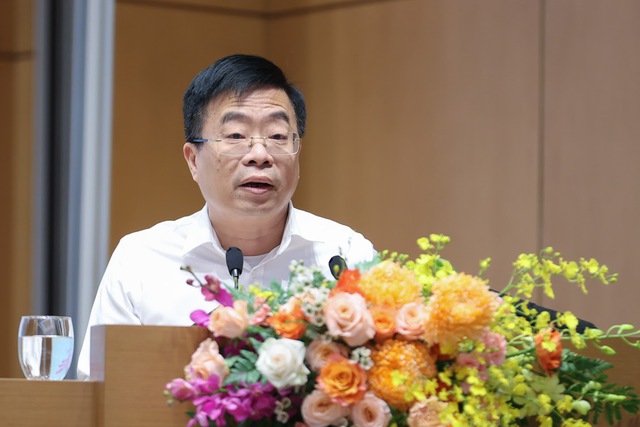
Photo: Government Newspaper
On the morning of March 14, Prime Minister Pham Minh Chinh and Deputy Prime Minister Le Minh Khai chaired a conference to implement the monetary policy tasks for 2024, focusing on resolving difficulties for production and business, promoting economic growth and stability.
At the conference, Mr. Le Tien Truong, Chairman of the Board of Directors of Vietnam Textile Group (Vinatex), presented his views from the perspective of the competitive export economy with many different countries and developing markets.
Mr. Truong said that the data was collected from the activities of textile and garment enterprises. With this limitation, the presentation of the group may not have a comprehensive overview of the macroeconomy.
First, comparing the exchange rates of the top 5 textile and garment exporting countries in the world. In the 2 years after the COVID-19 pandemic, major textile and garment exporting countries such as China, Vietnam, India, Bangladesh, and Turkey have shown a trend of stimulating exports.
These four countries use a powerful tool of devaluing their domestic currencies for exports. In terms of exchange rates, Vietnam’s textile and garment products have been more expensive than those of the top 5 countries by about 15%. This is why in 2022 and 2023, the textile and garment export industry decreased by 10%, the largest decrease among the top 5 garment exporting countries.
Secondly, regarding interest rates and credit policies. In general, the current interest rates of countries are around 3.5%. In Vietnam, the average borrowing rate is about 7% for good businesses and about 9% for bad businesses.
Bangladesh currently has an interest rate of about 8%, but the inflation rate is over 10%, so in terms of real positive interest rates, Vietnam has the highest real interest rate among textile and garment exporting countries. Specifically, the interest rate that Vinatex will have to pay to banks in 2023 increases by 10% compared to 2022, while the total debt decreases by 11%.
This means that the cost price becomes more expensive compared to 2022. Compared to 2021, with support, interest to be paid increases by 30%.
“Regarding the credit contracts that the group has in January and February 2024, it has not yet shown that the total interest to be paid in 2024 will be lower than that in 2023” – Mr. Truong said.
The special point is that textile and garment enterprises have no difficulty in accessing credit because the nature of textile and garment enterprises is that they will have profits if they have orders. However, throughout the past 18 months, the industry has faced difficulties in producing materials.
In which, the global yarn industry is unprofitable, not only in Vietnam. In 2022, access to capital was easy, in 2023 it was more difficult, and especially from the end of 2023 to the beginning of 2024, evaluating the 2024 credit limits for yarn industry businesses was very difficult.
Currently, all banks are reducing credit limits for yarn companies, or requiring 100% collateral for short-term loans in 2024. In 2023, the collateral value for loans was about 20% in general, this year it must be 100% or apply a repayment policy of 10, but only allowing to loan 8 or 9 parts.
According to Mr. Truong, now, some state-owned commercial banks provide loans at an interest rate of about 7% to yarn companies, commercial banks outside the state provide loans at an interest rate of about 9%.
Regarding other support policies, currently countries like China are maintaining highly supportive electricity prices. For yarn industry, China is applying a price of 4 cents/kw, only equal to 50% of Vietnam, and applies a 50% subsidy for domestic transportation prices, from March 1, 2023, until now.
“Therefore, without the support of banks, guidance from the Government and relevant ministries, we may lose the yarn industry”, Mr. Truong commented and cited: “Our yarn industry currently has 10 million spindles, the value of assets such as new investments is about 6 billion USD, the remaining value is about 3 billion USD, and currently pays about 300 million USD to banks every year.
If we reduce the credit limit, it might appear safe in the short term, but in reality it will be unsafe for long-term capital because without production, there will be no money to repay the long-term loans as before.”
In addition, the yarn industry is also maintaining 150,000 workers, paying about 1 billion USD in wages for workers, especially the yarn industry consumes a lot of electricity, paying about 500 million USD for electricity every year.
Mr. Truong believes that this is the story of the global economic cycle, all yarn companies face the same situation, so support for yarn companies in 2024 needs to be continued, without reducing the credit limit and without requiring fixed assets as collateral, to maintain production.
According to Mr. Truong, the interest rates have decreased but accessing loans is very difficult. On the other hand, the practical market in 2023 is much more difficult than in 2021 and 2022 due to China’s opening up and they are the world’s largest competitor. Until December 2023, a report from China showed that they had only mobilized 60% of the capacity of the textile and garment industry, so they continue to support policies to increase the rate.
Therefore, Mr. Truong believes: “The story of having support policies like during the COVID-19 period for this recovery phase is also very important for export industries.”
“And the final policy is related to the exchange rate. In the past 2 years, the exchange rate has only decreased by 5%, so export industries are facing many difficulties compared to other countries. We cannot say how much it should be reduced, but perhaps 5% is too little and difficult for the recovery of export industries.” – Mr. Truong said.















